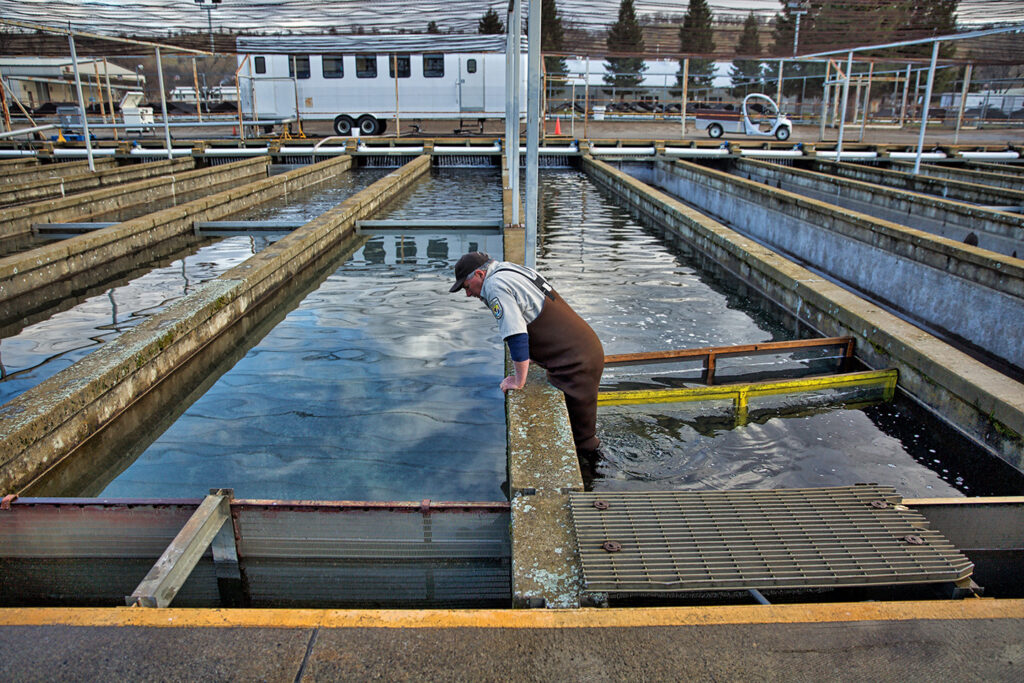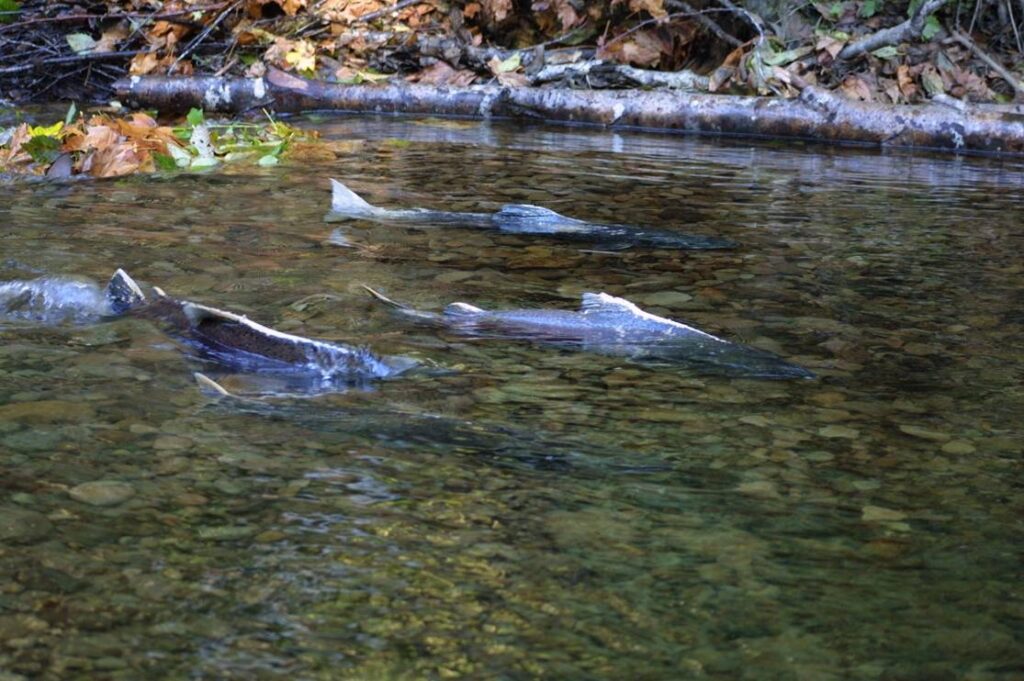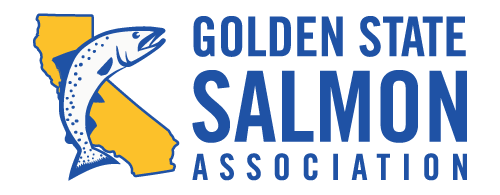Why Both Wild and Hatchery Salmon Matter More Than Ever
California’s salmon are in crisis. After three years of closures to commercial salmon fishing and the lowest returns on record, every fish that makes it home to spawn matters, whether it’s born in a gravel bed or a hatchery tank. As flows drop, rivers grow warmer, and habitat continues to shrink, hatcheries have become a vital bridge between today’s challenges and tomorrow’s recovery.
At the Golden State Salmon Association (GSSA), we believe the path forward isn’t about choosing wild or hatchery salmon. It’s about restoring rivers and improving hatcheries so both can thrive together.
A Short History of California’s Hatcheries
California’s salmon hatcheries were born out of necessity. When massive dams like Shasta, Oroville, and Folsom blocked historic spawning runs, hatcheries were built to compensate for the habitat that disappeared beneath the reservoirs. For decades, these facilities have provided the backbone of our salmon fishery, producing millions of baby salmon (or smolt) each year to support both ocean harvests and inland runs.

California’s Hatcheries, A Separate Lineage
Unlike the federally funded Mitchell Act hatcheries in the Pacific Northwest, California’s hatcheries were established under different authorities and funding mechanisms. Most were either state-built and operated by the California Department of Fish and Game (now CDFW) or created as federal mitigation facilities tied to specific water projects, especially the Central Valley Project (CVP).
Each major hatchery in the Central Valley tells a story of both loss and resilience:
- Nimbus Fish Hatchery (American River) → Built in 1955 by the U.S. Bureau of Reclamation and CDFW to replace spawning grounds lost when Folsom and Nimbus Dams blocked access to more than 80 miles of salmon habitat.
- Coleman National Fish Hatchery (Battle Creek, Sacramento River) → Established in 1942 by the U.S. Fish and Wildlife Service as mitigation for Shasta Dam, which closed off the entire upper Sacramento River, including important tributaries like the McCloud and Pit Rivers.
- Feather River Hatchery (Oroville) → Constructed in 1967 by the California Department of Water Resources and CDFW to offset the loss of spawning habitat caused by Oroville Dam on the Feather River.
- Mokelumne River Hatchery (Clements) → Completed in 1964 and operated jointly by East Bay Municipal Utility District (EBMUD) and CDFW as mitigation for Comanche Dam, sustaining runs that would have otherwise vanished.
Together, these facilities form the foundation of California’s modern salmon recovery system, built as project-specific commitments to sustain fish runs and fishing communities impacted by the state’s massive water infrastructure.
But hatcheries have evolved far beyond the concrete raceways of the 1960s. Modern programs now focus on conservation genetics, temperature control, and acclimation, not just mass production. They’re using cutting-edge science to produce stronger, more resilient fish while keeping wild populations viable.
Myths and Facts About Hatcheries
Myth 1: Hatchery fish are genetically inferior.
Fact: That might have been true decades ago, but some of today’s hatcheries use sophisticated genetic tracking, such as Parental-Based Tagging (PBT), to ensure a diverse gene pool. But today’s hatcheries use improved techniques to provide a more diversified genetics across salmon populations.
Myth 2: Hatchery fish harm wild fish.
Fact: When release timing and acclimation sites are carefully managed, the two can coexist. GSSA has long advocated for smarter trucking programs, downstream acclimation pens, and better coordination with water releases to minimize competition and boost survival.
Myth 3: We should only focus on wild fish recovery.
Fact: In a perfect world, California’s rivers would run cold and free, and wild salmon would flourish on their own. With degraded habitats, high river temperatures, and low river flows caused by drought and water policies that favor agriculture, hatcheries are essential to prevent total collapse. They give wild populations and the salmon industry a fighting chance while habitat restoration catches up.

The Science Behind Modern Hatcheries
Today’s hatchery scientists are using data and innovation to give salmon a better start in life.
- Genetic tagging (PBT): Now used on a fraction of California’s hatchery fish, PBT helps scientists trace lineage and monitor returns. PBT also allows hatchery managers to release juveniles earlier, when river conditions are better, compared to traditional coded wire tags.
- Acclimation & release strategies: Fish are trucked and released at sites that allow them to avoid steep losses in hostile river corridors, boosting survival.
- Temperature & flow management: The fact remains that temp and flow problems are the biggest impediment to CA salmon to this day.
GSSA continues to push for upgrades, smarter management, and the funding needed to keep this essential science moving forward.
The Balance: Wild and Hatchery Fish Together
The debate between wild and hatchery fish is often framed as an either-or choice. But the truth is, here in CA, we need both.
Wild fish represent the heart of salmon resilience and the ability to adapt and survive across generations. Hatchery fish, meanwhile, are the safety net that keeps the fishery alive for future generations of anglers, tribal communities, and coastal families. Additionally, hatcheries provide a genetic bank or reservoir where more native salmon genetics are sustained. Without hatcheries, we would lose not just a fishery but a way of life.
Hatcheries exist to mitigate the loss of salmon caused by the damage dams did to CA salmon rivers. They were built to replace the cold, free-flowing habitats lost to dams and diversions, and until those habitats are restored, hatcheries remain essential. The recent removal of the Klamath River dams is a powerful reminder of what’s possible when we begin to undo that damage. As rivers reopen and spawning grounds return, hatcheries can work hand in hand with natural recovery to rebuild self-sustaining runs.
As GSSA policy advisor Barry Nelson puts it, “We can’t restore wild salmon by abandoning hatcheries; we restore them by using hatcheries wisely while fixing the rivers they depend on.”
Challenges and Opportunities Ahead
California’s hatcheries face mounting threats, from funding cuts and outdated infrastructure to warming rivers and water mismanagement at both the state and federal levels. The recent announcement of drastic reductions at Nimbus Hatchery underscores how fragile this lifeline has become.
That’s why GSSA is working for:
- Full funding for state and federal hatcheries.
- Expansion of PBT and modern monitoring systems.
- Smarter, common-sense-based release location and timing to boost ocean survival.
When hatcheries succeed, so do fishermen, small businesses, and salmon communities across the state.
How You Can Help
Hatcheries are not a perfect solution; they’re a bridge to a better one. Think of California’s hatcheries as a stopgap measure. This initiative is put in place to maintain salmon runs while we work to restore our rivers to a more natural, free-flowing state. Supporting hatcheries, it turns out, is a means to protecting both our salmon and the people who depend on them.
Here’s how you can make a difference:
- Join GSSA — your membership fuels hatchery advocacy and restoration work.
- Donate — help fund campaigns for better management and modernization.
- Speak up — contact your state representatives when hatchery funding or water allocations are on the line.
- Share the message — tell your community why hatcheries matter.
Because until we restore our rivers, hatcheries are keeping hope – and salmon – alive. The Golden State Salmon Association (www.goldenstatesalmon.org) is a coalition of salmon advocates, including commercial and recreational salmon fishermen and women, businesses, restaurants, native tribes, environmentalists, elected officials, families, and communities that rely on salmon. GSSA’s mission is to restore California salmon for their economic, recreational, commercial, environmental, cultural, and health values.
